ACC511 Managerial Finance: Dell Laptop Plant Project Report Analysis
VerifiedAdded on 2023/01/20
|16
|1953
|46
Report
AI Summary
This report evaluates Dell's decision to invest in a new laptop manufacturing plant, requiring an initial outlay of $500 million. The analysis employs Net Present Value (NPV), Internal Rate of Return (IRR), and payback period methods to assess the project's financial viability over a ten-year period. The report details annual depreciation, cash flows, and terminal values, culminating in a positive NPV and an IRR exceeding the required return, indicating a profitable investment. Furthermore, the report examines the implications of a new financial discipline requiring projects to cover their financing costs annually and calculates the maximum interest rate permissible under this constraint. The report concludes with recommendations based on the financial analysis and a discussion of the risks and benefits of the new financial discipline.
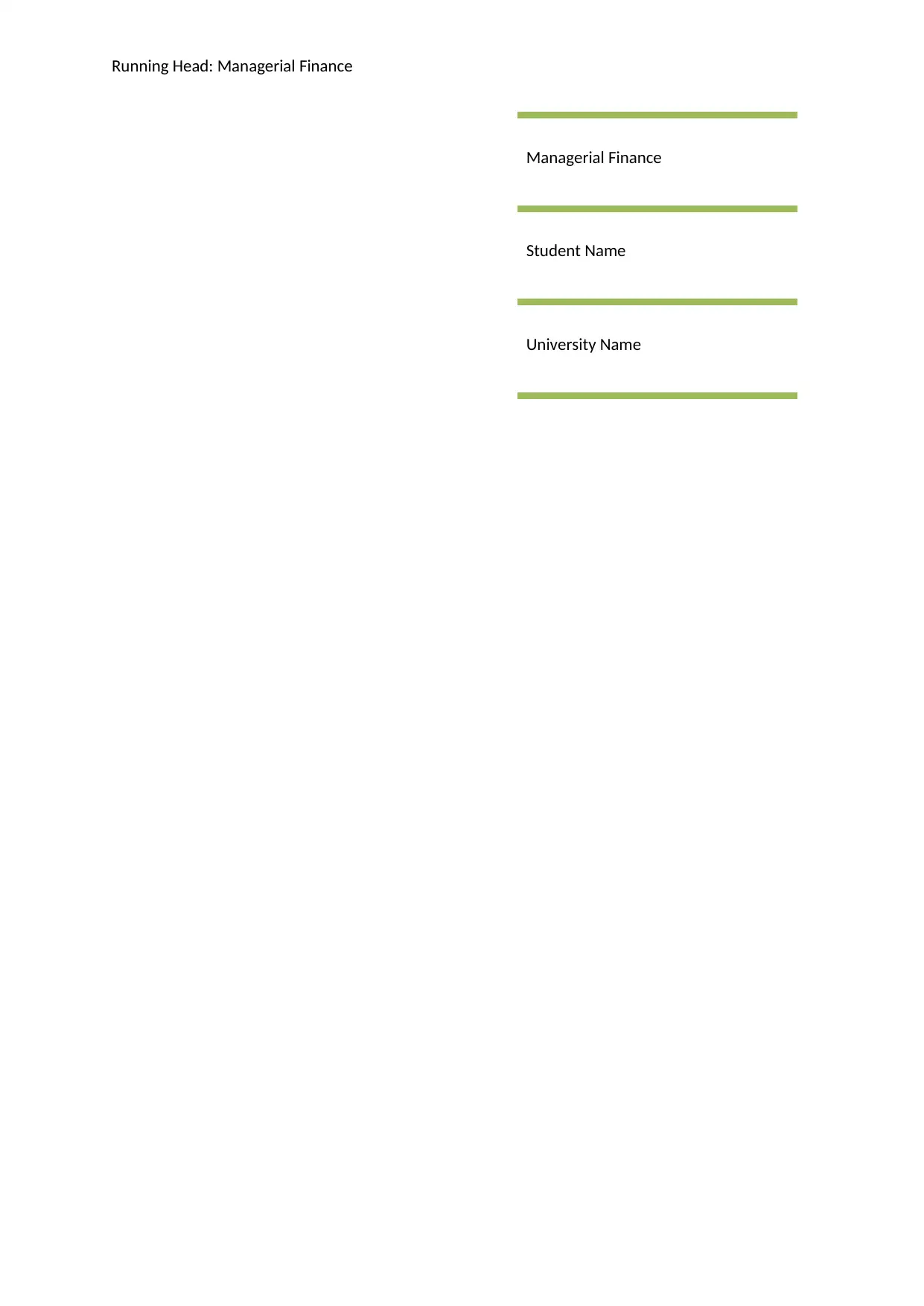
Running Head: Managerial Finance
Managerial Finance
Student Name
University Name
Managerial Finance
Student Name
University Name
Paraphrase This Document
Need a fresh take? Get an instant paraphrase of this document with our AI Paraphraser
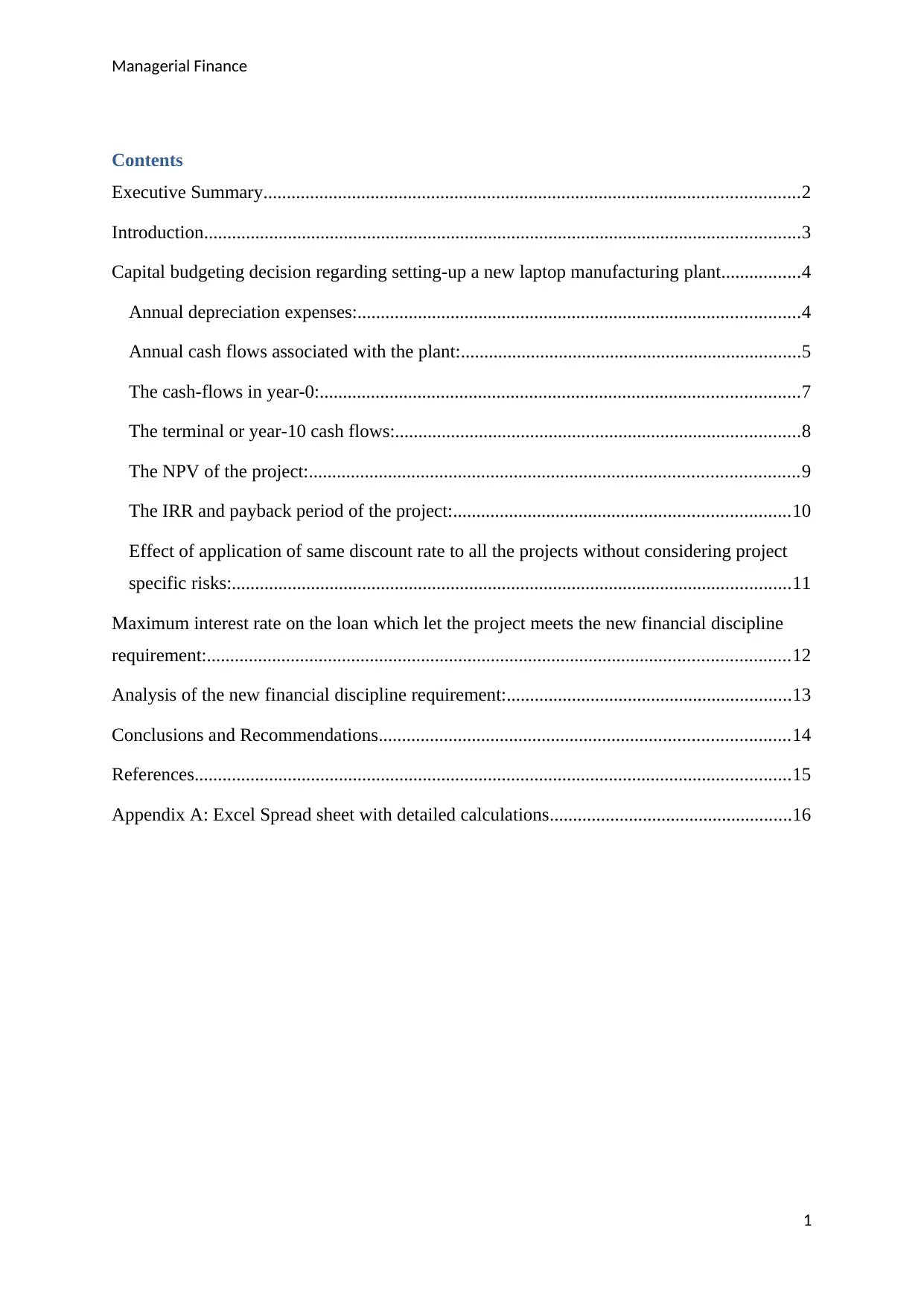
Managerial Finance
Contents
Executive Summary...................................................................................................................2
Introduction................................................................................................................................3
Capital budgeting decision regarding setting-up a new laptop manufacturing plant.................4
Annual depreciation expenses:...............................................................................................4
Annual cash flows associated with the plant:.........................................................................5
The cash-flows in year-0:.......................................................................................................7
The terminal or year-10 cash flows:.......................................................................................8
The NPV of the project:.........................................................................................................9
The IRR and payback period of the project:........................................................................10
Effect of application of same discount rate to all the projects without considering project
specific risks:........................................................................................................................11
Maximum interest rate on the loan which let the project meets the new financial discipline
requirement:.............................................................................................................................12
Analysis of the new financial discipline requirement:.............................................................13
Conclusions and Recommendations........................................................................................14
References................................................................................................................................15
Appendix A: Excel Spread sheet with detailed calculations....................................................16
1
Contents
Executive Summary...................................................................................................................2
Introduction................................................................................................................................3
Capital budgeting decision regarding setting-up a new laptop manufacturing plant.................4
Annual depreciation expenses:...............................................................................................4
Annual cash flows associated with the plant:.........................................................................5
The cash-flows in year-0:.......................................................................................................7
The terminal or year-10 cash flows:.......................................................................................8
The NPV of the project:.........................................................................................................9
The IRR and payback period of the project:........................................................................10
Effect of application of same discount rate to all the projects without considering project
specific risks:........................................................................................................................11
Maximum interest rate on the loan which let the project meets the new financial discipline
requirement:.............................................................................................................................12
Analysis of the new financial discipline requirement:.............................................................13
Conclusions and Recommendations........................................................................................14
References................................................................................................................................15
Appendix A: Excel Spread sheet with detailed calculations....................................................16
1
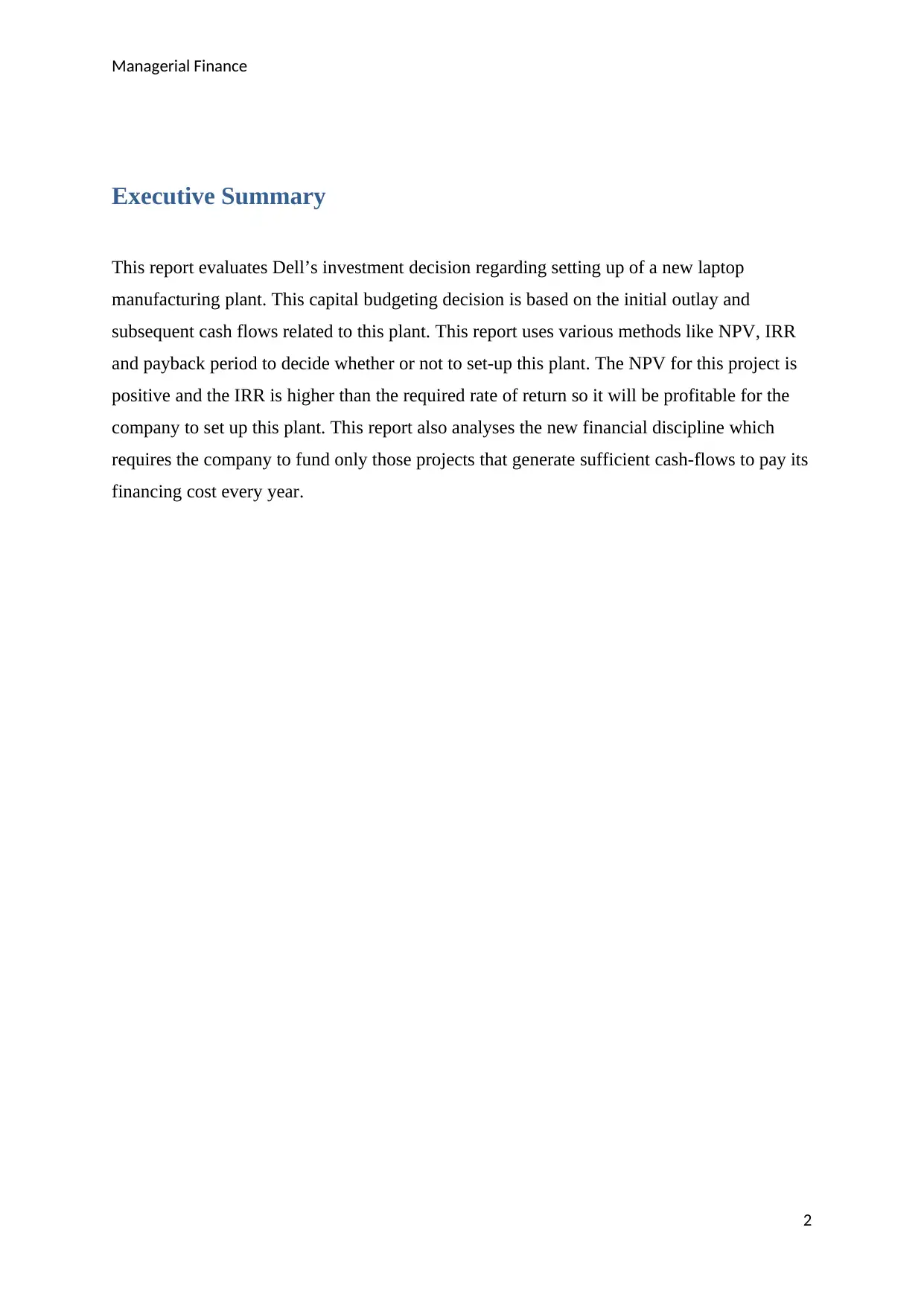
Managerial Finance
Executive Summary
This report evaluates Dell’s investment decision regarding setting up of a new laptop
manufacturing plant. This capital budgeting decision is based on the initial outlay and
subsequent cash flows related to this plant. This report uses various methods like NPV, IRR
and payback period to decide whether or not to set-up this plant. The NPV for this project is
positive and the IRR is higher than the required rate of return so it will be profitable for the
company to set up this plant. This report also analyses the new financial discipline which
requires the company to fund only those projects that generate sufficient cash-flows to pay its
financing cost every year.
2
Executive Summary
This report evaluates Dell’s investment decision regarding setting up of a new laptop
manufacturing plant. This capital budgeting decision is based on the initial outlay and
subsequent cash flows related to this plant. This report uses various methods like NPV, IRR
and payback period to decide whether or not to set-up this plant. The NPV for this project is
positive and the IRR is higher than the required rate of return so it will be profitable for the
company to set up this plant. This report also analyses the new financial discipline which
requires the company to fund only those projects that generate sufficient cash-flows to pay its
financing cost every year.
2
⊘ This is a preview!⊘
Do you want full access?
Subscribe today to unlock all pages.

Trusted by 1+ million students worldwide
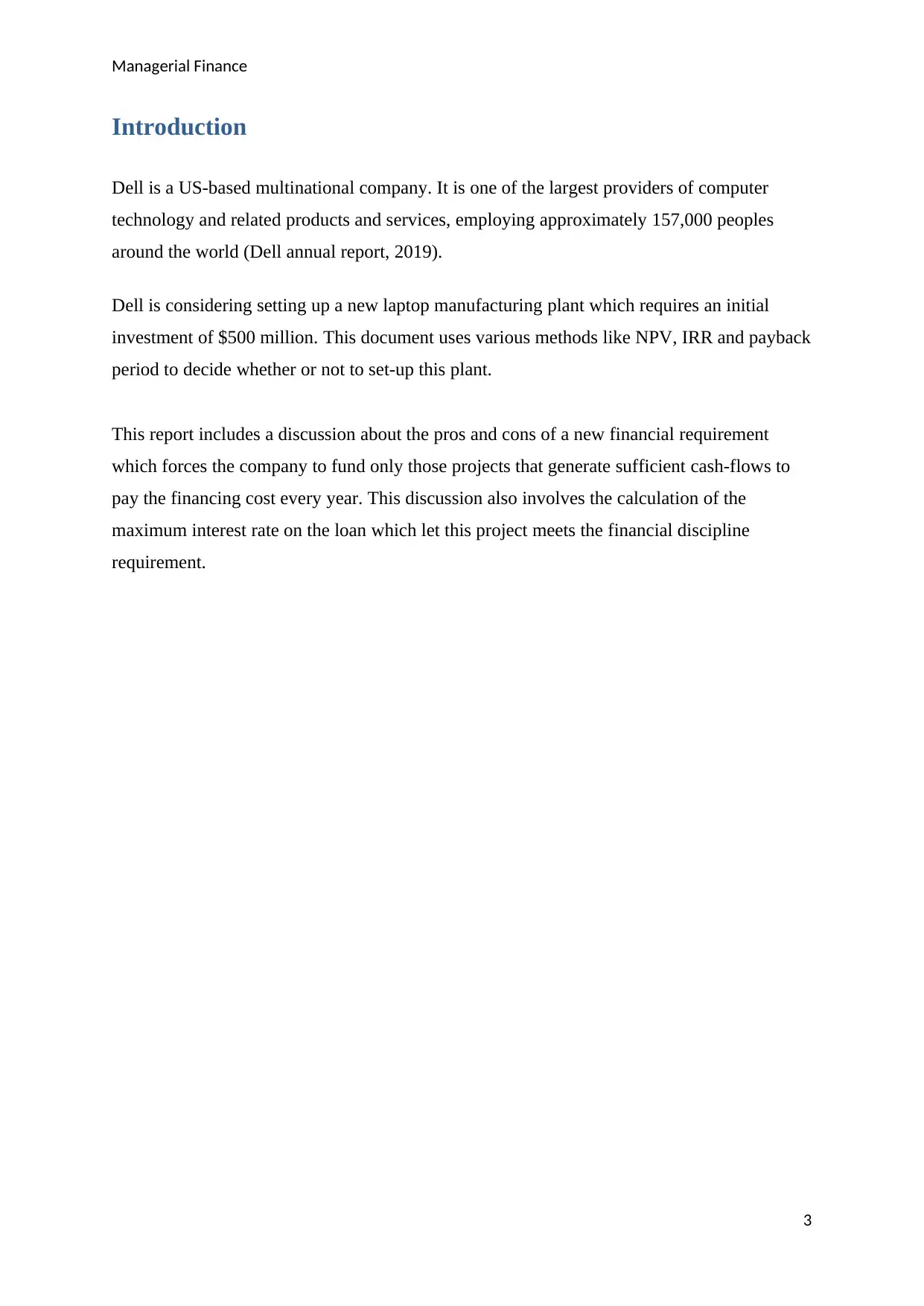
Managerial Finance
Introduction
Dell is a US-based multinational company. It is one of the largest providers of computer
technology and related products and services, employing approximately 157,000 peoples
around the world (Dell annual report, 2019).
Dell is considering setting up a new laptop manufacturing plant which requires an initial
investment of $500 million. This document uses various methods like NPV, IRR and payback
period to decide whether or not to set-up this plant.
This report includes a discussion about the pros and cons of a new financial requirement
which forces the company to fund only those projects that generate sufficient cash-flows to
pay the financing cost every year. This discussion also involves the calculation of the
maximum interest rate on the loan which let this project meets the financial discipline
requirement.
3
Introduction
Dell is a US-based multinational company. It is one of the largest providers of computer
technology and related products and services, employing approximately 157,000 peoples
around the world (Dell annual report, 2019).
Dell is considering setting up a new laptop manufacturing plant which requires an initial
investment of $500 million. This document uses various methods like NPV, IRR and payback
period to decide whether or not to set-up this plant.
This report includes a discussion about the pros and cons of a new financial requirement
which forces the company to fund only those projects that generate sufficient cash-flows to
pay the financing cost every year. This discussion also involves the calculation of the
maximum interest rate on the loan which let this project meets the financial discipline
requirement.
3
Paraphrase This Document
Need a fresh take? Get an instant paraphrase of this document with our AI Paraphraser
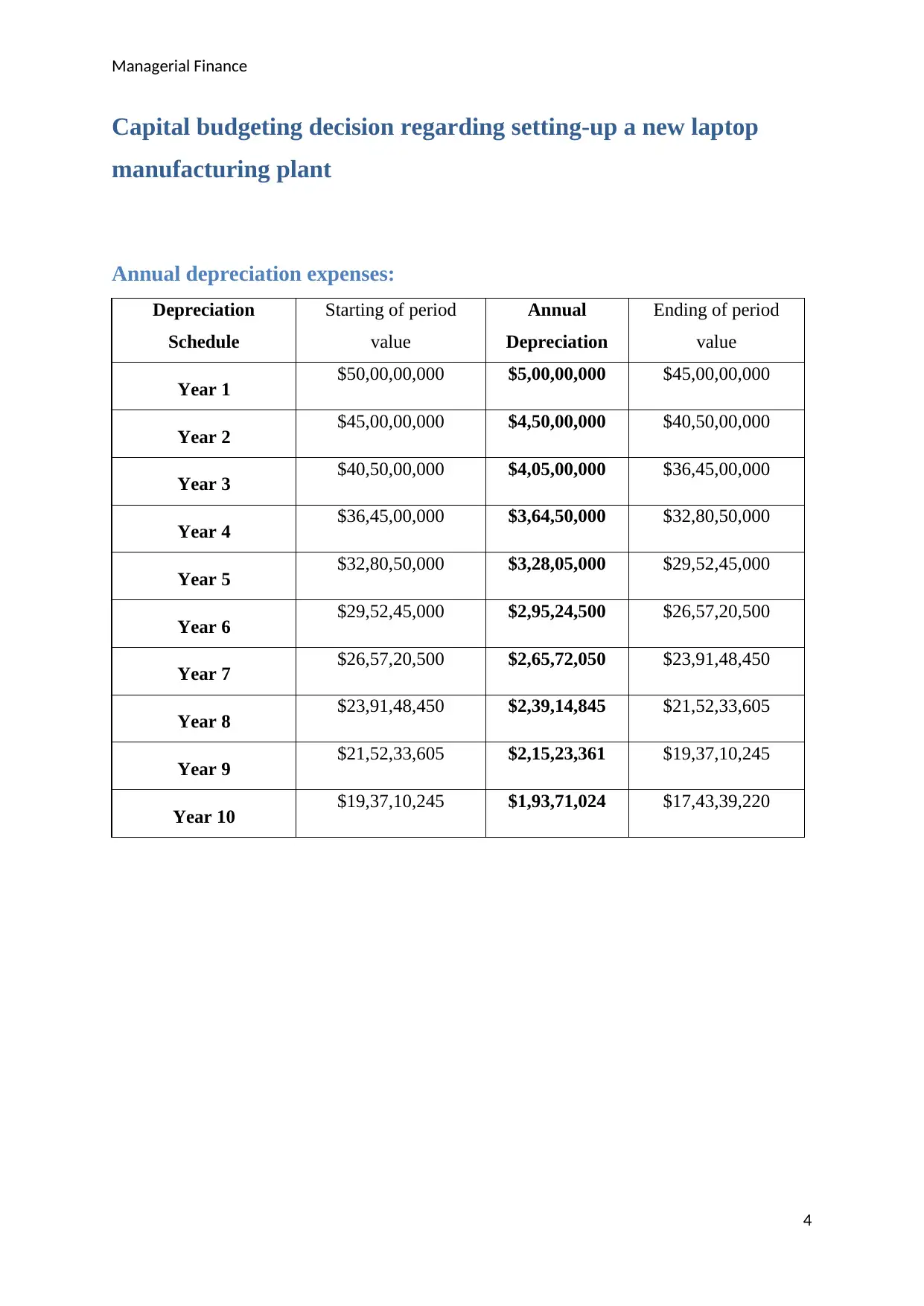
Managerial Finance
Capital budgeting decision regarding setting-up a new laptop
manufacturing plant
Annual depreciation expenses:
Depreciation
Schedule
Starting of period
value
Annual
Depreciation
Ending of period
value
Year 1 $50,00,00,000 $5,00,00,000 $45,00,00,000
Year 2 $45,00,00,000 $4,50,00,000 $40,50,00,000
Year 3 $40,50,00,000 $4,05,00,000 $36,45,00,000
Year 4 $36,45,00,000 $3,64,50,000 $32,80,50,000
Year 5 $32,80,50,000 $3,28,05,000 $29,52,45,000
Year 6 $29,52,45,000 $2,95,24,500 $26,57,20,500
Year 7 $26,57,20,500 $2,65,72,050 $23,91,48,450
Year 8 $23,91,48,450 $2,39,14,845 $21,52,33,605
Year 9 $21,52,33,605 $2,15,23,361 $19,37,10,245
Year 10 $19,37,10,245 $1,93,71,024 $17,43,39,220
4
Capital budgeting decision regarding setting-up a new laptop
manufacturing plant
Annual depreciation expenses:
Depreciation
Schedule
Starting of period
value
Annual
Depreciation
Ending of period
value
Year 1 $50,00,00,000 $5,00,00,000 $45,00,00,000
Year 2 $45,00,00,000 $4,50,00,000 $40,50,00,000
Year 3 $40,50,00,000 $4,05,00,000 $36,45,00,000
Year 4 $36,45,00,000 $3,64,50,000 $32,80,50,000
Year 5 $32,80,50,000 $3,28,05,000 $29,52,45,000
Year 6 $29,52,45,000 $2,95,24,500 $26,57,20,500
Year 7 $26,57,20,500 $2,65,72,050 $23,91,48,450
Year 8 $23,91,48,450 $2,39,14,845 $21,52,33,605
Year 9 $21,52,33,605 $2,15,23,361 $19,37,10,245
Year 10 $19,37,10,245 $1,93,71,024 $17,43,39,220
4
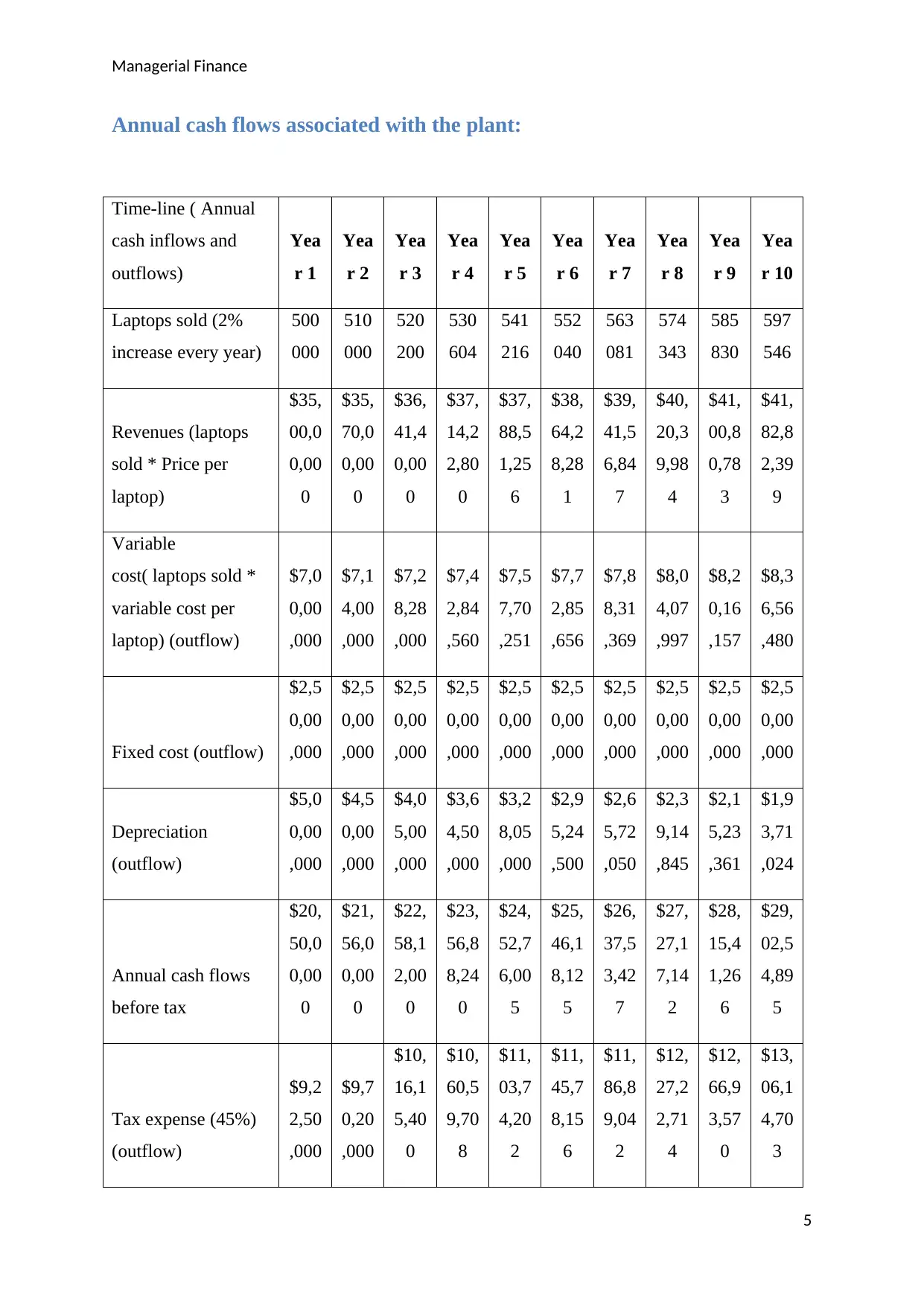
Managerial Finance
Annual cash flows associated with the plant:
Time-line ( Annual
cash inflows and
outflows)
Yea
r 1
Yea
r 2
Yea
r 3
Yea
r 4
Yea
r 5
Yea
r 6
Yea
r 7
Yea
r 8
Yea
r 9
Yea
r 10
Laptops sold (2%
increase every year)
500
000
510
000
520
200
530
604
541
216
552
040
563
081
574
343
585
830
597
546
Revenues (laptops
sold * Price per
laptop)
$35,
00,0
0,00
0
$35,
70,0
0,00
0
$36,
41,4
0,00
0
$37,
14,2
2,80
0
$37,
88,5
1,25
6
$38,
64,2
8,28
1
$39,
41,5
6,84
7
$40,
20,3
9,98
4
$41,
00,8
0,78
3
$41,
82,8
2,39
9
Variable
cost( laptops sold *
variable cost per
laptop) (outflow)
$7,0
0,00
,000
$7,1
4,00
,000
$7,2
8,28
,000
$7,4
2,84
,560
$7,5
7,70
,251
$7,7
2,85
,656
$7,8
8,31
,369
$8,0
4,07
,997
$8,2
0,16
,157
$8,3
6,56
,480
Fixed cost (outflow)
$2,5
0,00
,000
$2,5
0,00
,000
$2,5
0,00
,000
$2,5
0,00
,000
$2,5
0,00
,000
$2,5
0,00
,000
$2,5
0,00
,000
$2,5
0,00
,000
$2,5
0,00
,000
$2,5
0,00
,000
Depreciation
(outflow)
$5,0
0,00
,000
$4,5
0,00
,000
$4,0
5,00
,000
$3,6
4,50
,000
$3,2
8,05
,000
$2,9
5,24
,500
$2,6
5,72
,050
$2,3
9,14
,845
$2,1
5,23
,361
$1,9
3,71
,024
Annual cash flows
before tax
$20,
50,0
0,00
0
$21,
56,0
0,00
0
$22,
58,1
2,00
0
$23,
56,8
8,24
0
$24,
52,7
6,00
5
$25,
46,1
8,12
5
$26,
37,5
3,42
7
$27,
27,1
7,14
2
$28,
15,4
1,26
6
$29,
02,5
4,89
5
Tax expense (45%)
(outflow)
$9,2
2,50
,000
$9,7
0,20
,000
$10,
16,1
5,40
0
$10,
60,5
9,70
8
$11,
03,7
4,20
2
$11,
45,7
8,15
6
$11,
86,8
9,04
2
$12,
27,2
2,71
4
$12,
66,9
3,57
0
$13,
06,1
4,70
3
5
Annual cash flows associated with the plant:
Time-line ( Annual
cash inflows and
outflows)
Yea
r 1
Yea
r 2
Yea
r 3
Yea
r 4
Yea
r 5
Yea
r 6
Yea
r 7
Yea
r 8
Yea
r 9
Yea
r 10
Laptops sold (2%
increase every year)
500
000
510
000
520
200
530
604
541
216
552
040
563
081
574
343
585
830
597
546
Revenues (laptops
sold * Price per
laptop)
$35,
00,0
0,00
0
$35,
70,0
0,00
0
$36,
41,4
0,00
0
$37,
14,2
2,80
0
$37,
88,5
1,25
6
$38,
64,2
8,28
1
$39,
41,5
6,84
7
$40,
20,3
9,98
4
$41,
00,8
0,78
3
$41,
82,8
2,39
9
Variable
cost( laptops sold *
variable cost per
laptop) (outflow)
$7,0
0,00
,000
$7,1
4,00
,000
$7,2
8,28
,000
$7,4
2,84
,560
$7,5
7,70
,251
$7,7
2,85
,656
$7,8
8,31
,369
$8,0
4,07
,997
$8,2
0,16
,157
$8,3
6,56
,480
Fixed cost (outflow)
$2,5
0,00
,000
$2,5
0,00
,000
$2,5
0,00
,000
$2,5
0,00
,000
$2,5
0,00
,000
$2,5
0,00
,000
$2,5
0,00
,000
$2,5
0,00
,000
$2,5
0,00
,000
$2,5
0,00
,000
Depreciation
(outflow)
$5,0
0,00
,000
$4,5
0,00
,000
$4,0
5,00
,000
$3,6
4,50
,000
$3,2
8,05
,000
$2,9
5,24
,500
$2,6
5,72
,050
$2,3
9,14
,845
$2,1
5,23
,361
$1,9
3,71
,024
Annual cash flows
before tax
$20,
50,0
0,00
0
$21,
56,0
0,00
0
$22,
58,1
2,00
0
$23,
56,8
8,24
0
$24,
52,7
6,00
5
$25,
46,1
8,12
5
$26,
37,5
3,42
7
$27,
27,1
7,14
2
$28,
15,4
1,26
6
$29,
02,5
4,89
5
Tax expense (45%)
(outflow)
$9,2
2,50
,000
$9,7
0,20
,000
$10,
16,1
5,40
0
$10,
60,5
9,70
8
$11,
03,7
4,20
2
$11,
45,7
8,15
6
$11,
86,8
9,04
2
$12,
27,2
2,71
4
$12,
66,9
3,57
0
$13,
06,1
4,70
3
5
⊘ This is a preview!⊘
Do you want full access?
Subscribe today to unlock all pages.

Trusted by 1+ million students worldwide
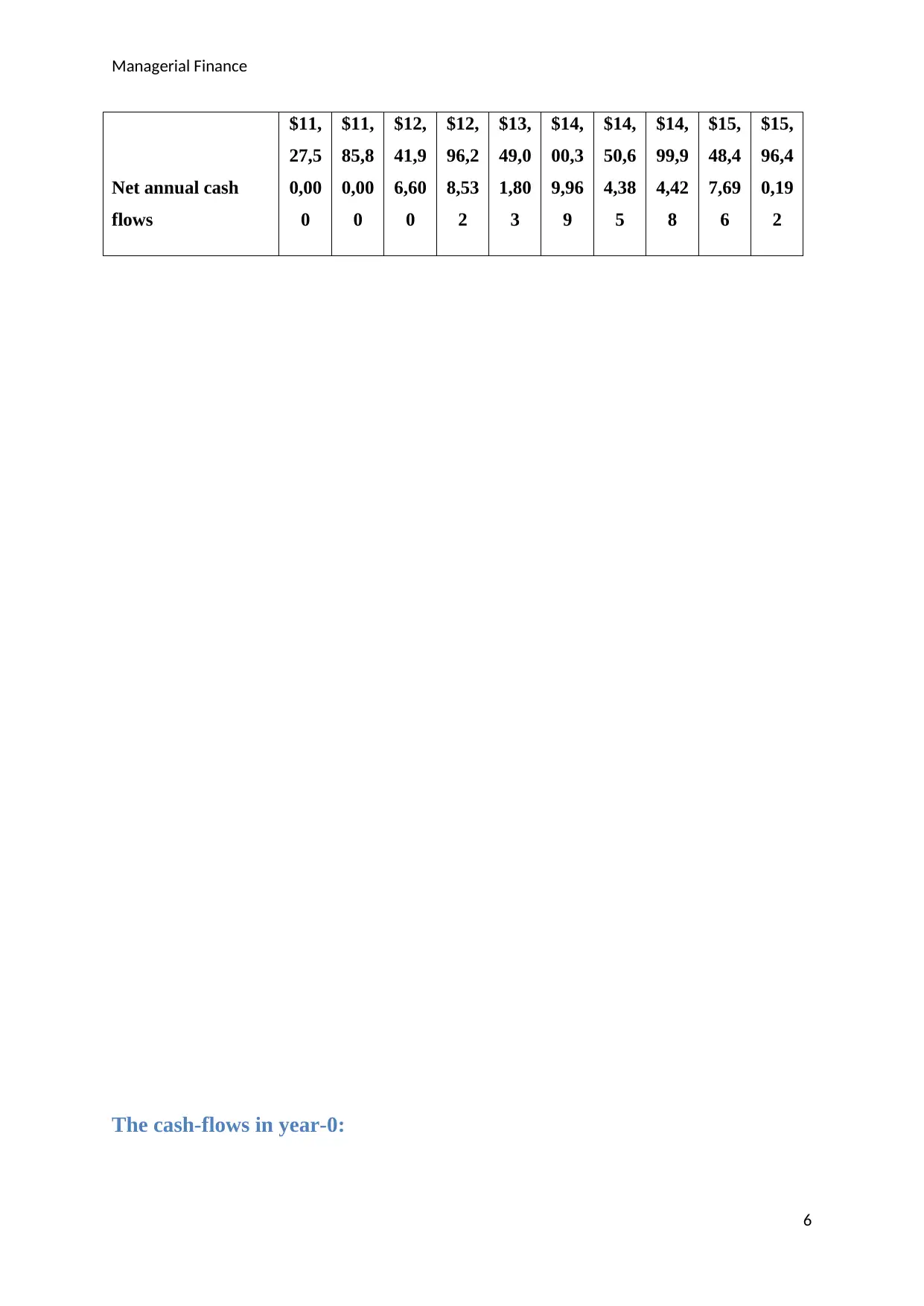
Managerial Finance
Net annual cash
flows
$11,
27,5
0,00
0
$11,
85,8
0,00
0
$12,
41,9
6,60
0
$12,
96,2
8,53
2
$13,
49,0
1,80
3
$14,
00,3
9,96
9
$14,
50,6
4,38
5
$14,
99,9
4,42
8
$15,
48,4
7,69
6
$15,
96,4
0,19
2
The cash-flows in year-0:
6
Net annual cash
flows
$11,
27,5
0,00
0
$11,
85,8
0,00
0
$12,
41,9
6,60
0
$12,
96,2
8,53
2
$13,
49,0
1,80
3
$14,
00,3
9,96
9
$14,
50,6
4,38
5
$14,
99,9
4,42
8
$15,
48,4
7,69
6
$15,
96,4
0,19
2
The cash-flows in year-0:
6
Paraphrase This Document
Need a fresh take? Get an instant paraphrase of this document with our AI Paraphraser
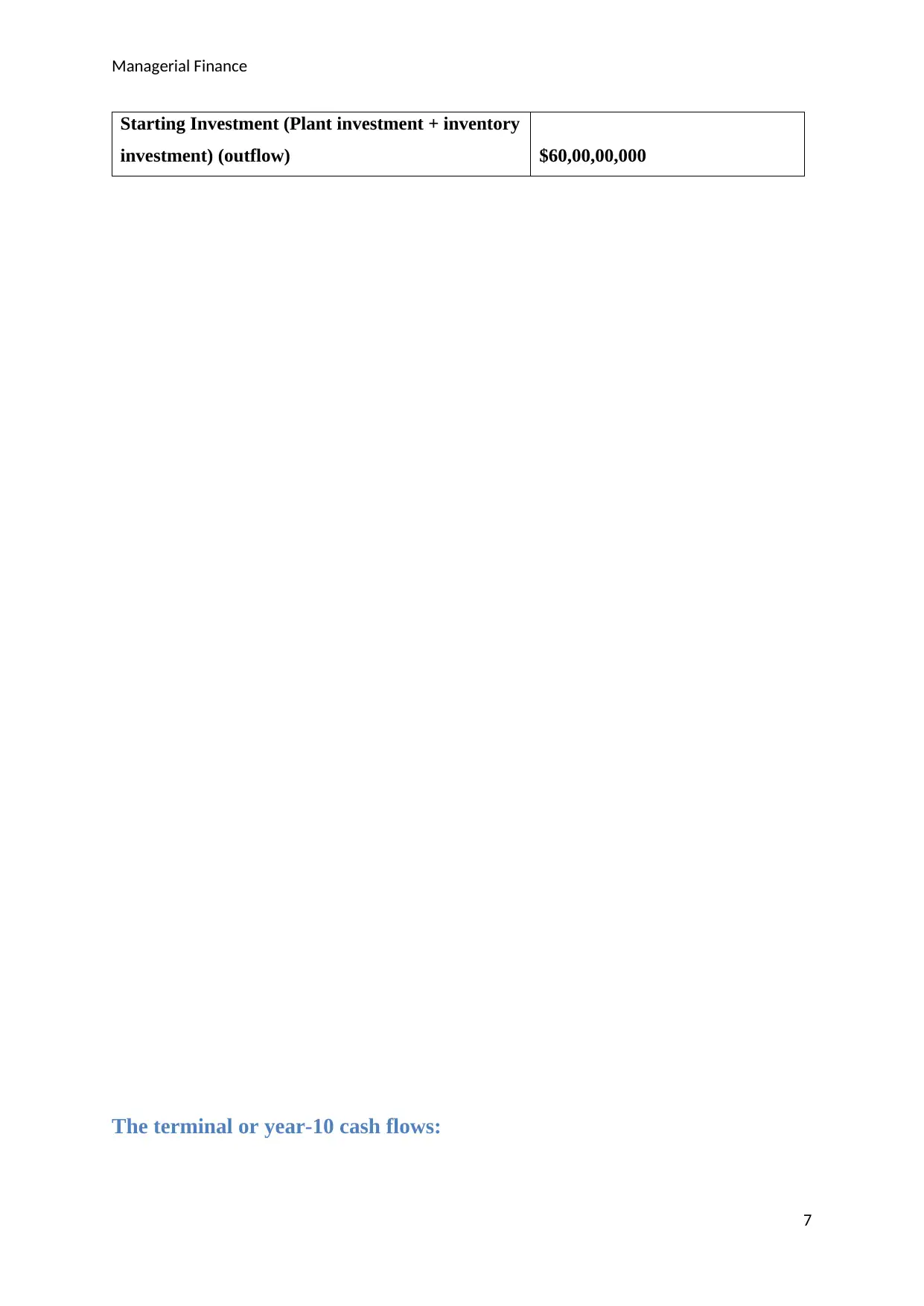
Managerial Finance
Starting Investment (Plant investment + inventory
investment) (outflow) $60,00,00,000
The terminal or year-10 cash flows:
7
Starting Investment (Plant investment + inventory
investment) (outflow) $60,00,00,000
The terminal or year-10 cash flows:
7

Managerial Finance
Annual cash flows for year 10 $29,02,54,895
Terminal value of the plant at end of year 10 $15,00,00,000
Recovered amount from the inventory investment at end of year
10 $10,00,00,000
Total year 10 cash flows $54,02,54,895
The NPV of the project:
8
Annual cash flows for year 10 $29,02,54,895
Terminal value of the plant at end of year 10 $15,00,00,000
Recovered amount from the inventory investment at end of year
10 $10,00,00,000
Total year 10 cash flows $54,02,54,895
The NPV of the project:
8
⊘ This is a preview!⊘
Do you want full access?
Subscribe today to unlock all pages.

Trusted by 1+ million students worldwide
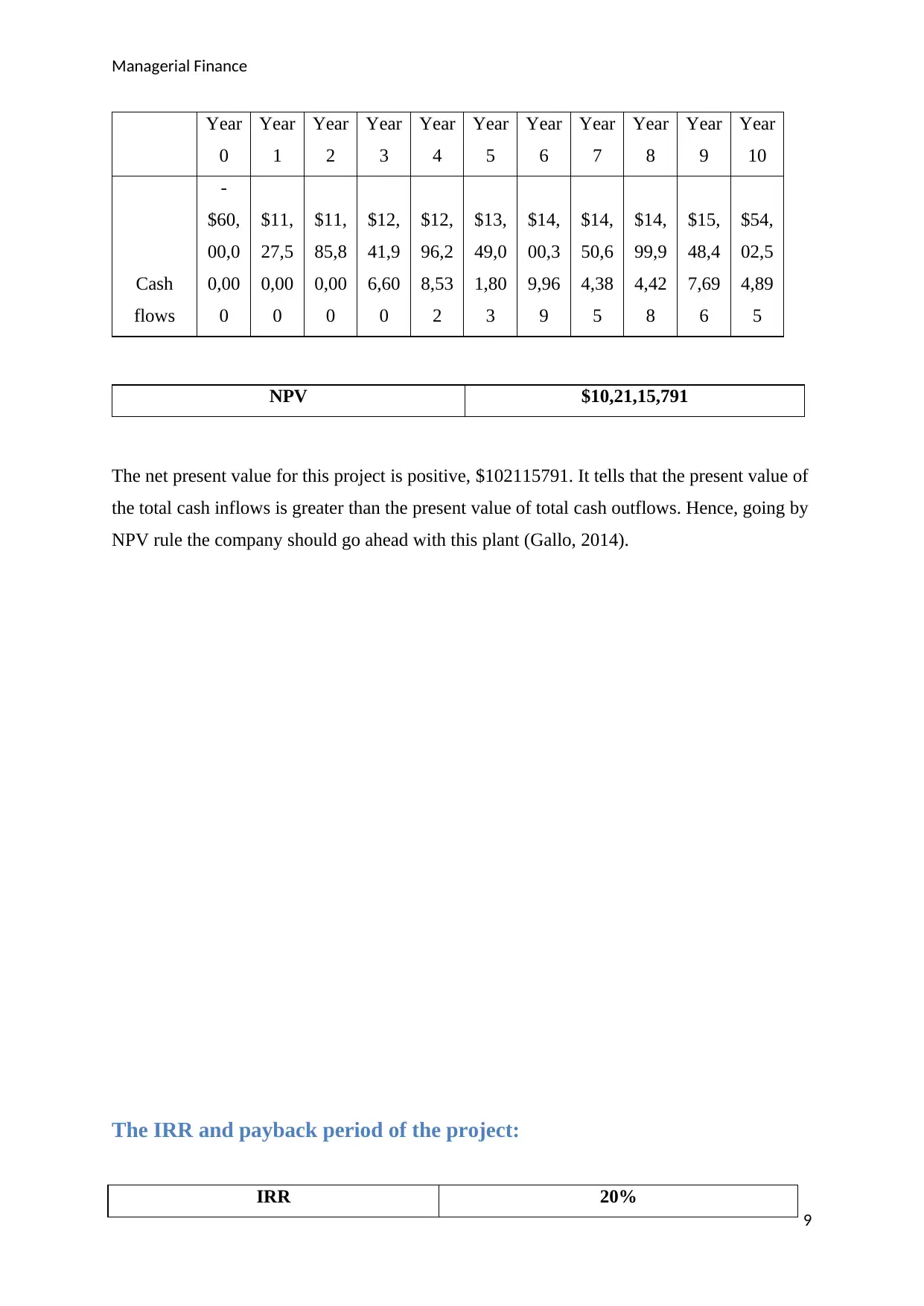
Managerial Finance
Year
0
Year
1
Year
2
Year
3
Year
4
Year
5
Year
6
Year
7
Year
8
Year
9
Year
10
Cash
flows
-
$60,
00,0
0,00
0
$11,
27,5
0,00
0
$11,
85,8
0,00
0
$12,
41,9
6,60
0
$12,
96,2
8,53
2
$13,
49,0
1,80
3
$14,
00,3
9,96
9
$14,
50,6
4,38
5
$14,
99,9
4,42
8
$15,
48,4
7,69
6
$54,
02,5
4,89
5
NPV $10,21,15,791
The net present value for this project is positive, $102115791. It tells that the present value of
the total cash inflows is greater than the present value of total cash outflows. Hence, going by
NPV rule the company should go ahead with this plant (Gallo, 2014).
The IRR and payback period of the project:
9
IRR 20%
Year
0
Year
1
Year
2
Year
3
Year
4
Year
5
Year
6
Year
7
Year
8
Year
9
Year
10
Cash
flows
-
$60,
00,0
0,00
0
$11,
27,5
0,00
0
$11,
85,8
0,00
0
$12,
41,9
6,60
0
$12,
96,2
8,53
2
$13,
49,0
1,80
3
$14,
00,3
9,96
9
$14,
50,6
4,38
5
$14,
99,9
4,42
8
$15,
48,4
7,69
6
$54,
02,5
4,89
5
NPV $10,21,15,791
The net present value for this project is positive, $102115791. It tells that the present value of
the total cash inflows is greater than the present value of total cash outflows. Hence, going by
NPV rule the company should go ahead with this plant (Gallo, 2014).
The IRR and payback period of the project:
9
IRR 20%
Paraphrase This Document
Need a fresh take? Get an instant paraphrase of this document with our AI Paraphraser

Managerial Finance
The IRR of 20% is higher than the required return of 16%. So, it will be profitable to set up
this plant going by the internal rate of return rule (Gallo, 2016).
Payback period 4.85 years
The payback period of 4.85 tells that it will take 4.85 years for this plant to recover the initial
investment amount (or to reach breakeven). This breakeven point can be compared with the
company's target time-period to recover initial outlay if the payback period is shorter than
this target then the company should set up this plant.
Effect of application of the same discount rate to all the projects without
considering project-specific risks:
It makes more sense to adjust the discount rate according to the project specific risk. For
example, if any project is riskier, then its discount rate factor should be increased. Such
10
The IRR of 20% is higher than the required return of 16%. So, it will be profitable to set up
this plant going by the internal rate of return rule (Gallo, 2016).
Payback period 4.85 years
The payback period of 4.85 tells that it will take 4.85 years for this plant to recover the initial
investment amount (or to reach breakeven). This breakeven point can be compared with the
company's target time-period to recover initial outlay if the payback period is shorter than
this target then the company should set up this plant.
Effect of application of the same discount rate to all the projects without
considering project-specific risks:
It makes more sense to adjust the discount rate according to the project specific risk. For
example, if any project is riskier, then its discount rate factor should be increased. Such
10

Managerial Finance
discount rate adjustment will result in the reduced present value of the project's future cash
flows indicating the increased uncertainty related to the project.
The maximum interest rate on the loan which let the project
meets the new financial discipline requirement
Cash flows:
11
discount rate adjustment will result in the reduced present value of the project's future cash
flows indicating the increased uncertainty related to the project.
The maximum interest rate on the loan which let the project
meets the new financial discipline requirement
Cash flows:
11
⊘ This is a preview!⊘
Do you want full access?
Subscribe today to unlock all pages.

Trusted by 1+ million students worldwide
1 out of 16
Related Documents
Your All-in-One AI-Powered Toolkit for Academic Success.
+13062052269
info@desklib.com
Available 24*7 on WhatsApp / Email
![[object Object]](/_next/static/media/star-bottom.7253800d.svg)
Unlock your academic potential
Copyright © 2020–2025 A2Z Services. All Rights Reserved. Developed and managed by ZUCOL.





